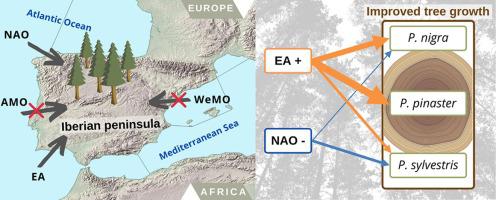Forest Ecology and Management ( IF 3.7 ) Pub Date : 2021-01-15 , DOI: 10.1016/j.foreco.2021.118921 Héctor Hernández-Alonso , Jaime Madrigal-González , Fernando Silla

|
Large-scale climate indices, such as the Atlantic Multidecadal Oscillation (AMO), the East-Atlantic pattern (EA), the North-Atlantic Oscillation (NAO) and the Western Mediterranean Oscillation (WeMO), are recognized as important drivers of tree growth and forest productivity in south-western Europe. However, it is still poorly understood whether species respond to these climatic influences differently. Do different pine tree species respond similarly to the main climatic patterns in south-western Europe? If not, will the species respond according to what should be expected from their biogeographical character? Here we analyse the paper of climatic patterns on tree growth in a mountainous Mediterranean environment where three contrasting pine species cohabit (Pinus nigra, P. pinaster and P. sylvestris). We first identified the climatic patterns that most influence temperature and precipitation variability during the coldest months of the year. Secondly, we evaluated the role of these climatic patterns as drivers of Basal Area Increments (BAI) using mixed-effect models separately for each of the three pines considered. A backward model selection was applied using AICc. Only two out of the four climatic patterns analysed were supported as potential drivers of temperature and precipitation variability in our study site. Specifically, EA correlated positively with temperatures and precipitation, whereas NAO correlated negatively with precipitation. Model selection supported both EA and NAO as important drivers of BAI in P. nigra and P. sylvestris, while P. pinaster was sensitive to EA. Our results highlight EA as the most influential climatic driver of tree growth in this area. Furthermore, and according to the biogeographical characters of the species studied, the models show how high temperatures influence P. pinaster the most, while P. sylvestris is the most sensitive species to precipitation variability. Our findings show the existence of clear species-specific differences in tree growth responses to climatic variability patterns.
中文翻译:

在不同的生长反应黑松,P.松树和P.樟子松气候变化的主要模式在西部地中海
大规模的气候指数,例如大西洋多年代际涛动(AMO),东大西洋格局(EA),北大西洋涛动(NAO)和西地中海涛动(WeMO),被认为是树木生长的重要驱动力和西南欧的森林生产力。然而,人们对物种是否对这些气候影响做出不同反应仍知之甚少。不同的松树树种对欧洲西南部的主要气候格局有相似的反应吗?如果不是,该物种是否会根据其生物地理特征所期望的做出反应?在这里,我们分析了山区地中海环境中树木生长的气候模式的论文,地中海环境中三种相反的松树物种同时存在(黑松,松树和P. sylvestris)。我们首先确定了在一年中最冷的月份最能影响温度和降水变化的气候模式。其次,我们针对所考虑的三个松树分别使用混合效应模型评估了这些气候模式作为基础面积增加量(BAI)的驱动因素的作用。使用AICc进行了向后模型选择。在我们的研究地点,所分析的四种气候模式中只有两种被认为是温度和降水变化的潜在驱动因素。具体而言,EA与温度和降水呈正相关,而NAO与降水呈负相关。模型选择支持EA和NAO作为黑斑病菌和樟子松的BAI的重要驱动力,而P. pinaster对EA敏感。我们的结果表明,EA是该地区树木生长最有影响力的气候驱动因素。此外,根据所研究物种的生物地理特征,这些模型显示了高温对P. pinaster的影响最大,而P. sylvestris对降水变化最敏感。我们的发现表明,树木对气候变异模式的响应存在明显的物种特异性差异。











































 京公网安备 11010802027423号
京公网安备 11010802027423号